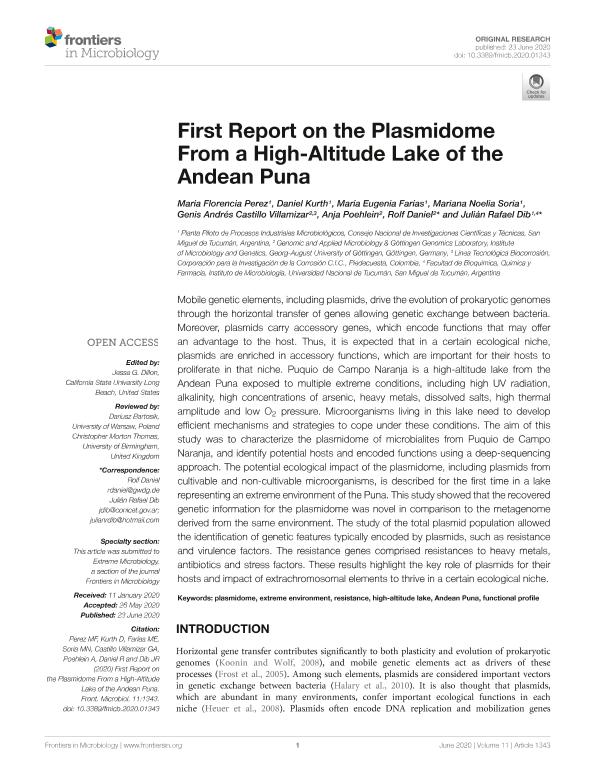Mostrar el registro sencillo del ítem
dc.contributor.author
Perez, Maria Florencia

dc.contributor.author
Kurth, Daniel German

dc.contributor.author
Farias, Maria Eugenia

dc.contributor.author
Soria, Mariana Noelia

dc.contributor.author
Castillo Villamizar, Genis Andrés
dc.contributor.author
Poehlein, Anja
dc.contributor.author
Daniel, Rolf
dc.contributor.author
Dib, Julian Rafael

dc.date.available
2021-09-03T15:54:46Z
dc.date.issued
2020-06
dc.identifier.citation
Perez, Maria Florencia; Kurth, Daniel German; Farias, Maria Eugenia; Soria, Mariana Noelia; Castillo Villamizar, Genis Andrés; et al.; First Report on the Plasmidome From a High-Altitude Lake of the Andean Puna; Frontiers Media SA; Frontiers in Microbiology; 11; 6-2020
dc.identifier.issn
1664-302X
dc.identifier.uri
http://hdl.handle.net/11336/139649
dc.description.abstract
Mobile genetic elements, including plasmids, drive the evolution of prokaryotic genomes through the horizontal transfer of genes allowing genetic exchange between bacteria. Moreover, plasmids carry accessory genes, which encode functions that may offer an advantage to the host. Thus, it is expected that in a certain ecological niche, plasmids are enriched in accessory functions, which are important for their hosts to proliferate in that niche. Puquio de Campo Naranja is a high-altitude lake from the Andean Puna exposed to multiple extreme conditions, including high UV radiation, alkalinity, high concentrations of arsenic, heavy metals, dissolved salts, high thermal amplitude and low O2 pressure. Microorganisms living in this lake need to develop efficient mechanisms and strategies to cope under these conditions. The aim of this study was to characterize the plasmidome of microbialites from Puquio de Campo Naranja, and identify potential hosts and encoded functions using a deep-sequencing approach. The potential ecological impact of the plasmidome, including plasmids from cultivable and non-cultivable microorganisms, is described for the first time in a lake representing an extreme environment of the Puna. This study showed that the recovered genetic information for the plasmidome was novel in comparison to the metagenome derived from the same environment. The study of the total plasmid population allowed the identification of genetic features typically encoded by plasmids, such as resistance and virulence factors. The resistance genes comprised resistances to heavy metals, antibiotics and stress factors. These results highlight the key role of plasmids for their hosts and impact of extrachromosomal elements to thrive in a certain ecological niche.
dc.format
application/pdf
dc.language.iso
eng
dc.publisher
Frontiers Media SA
dc.rights
info:eu-repo/semantics/openAccess
dc.rights.uri
https://creativecommons.org/licenses/by-nc-sa/2.5/ar/
dc.subject
PLASMIDOME
dc.subject
EXTREME ENVIRONMENT
dc.subject
RESISTANCE
dc.subject
HIGH-ALTITUDE LAKE
dc.subject
ANDEAN PUNA
dc.subject
FUNCTIONAL PROFILE
dc.subject.classification
Biología Celular, Microbiología

dc.subject.classification
Ciencias Biológicas

dc.subject.classification
CIENCIAS NATURALES Y EXACTAS

dc.title
First Report on the Plasmidome From a High-Altitude Lake of the Andean Puna
dc.type
info:eu-repo/semantics/article
dc.type
info:ar-repo/semantics/artículo
dc.type
info:eu-repo/semantics/publishedVersion
dc.date.updated
2021-09-01T13:49:52Z
dc.journal.volume
11
dc.journal.pais
Estados Unidos

dc.journal.ciudad
New Jersey
dc.description.fil
Fil: Perez, Maria Florencia. Consejo Nacional de Investigaciones Científicas y Técnicas. Centro Científico Tecnológico Conicet - Tucumán. Planta Piloto de Procesos Industriales Microbiológicos; Argentina
dc.description.fil
Fil: Kurth, Daniel German. Consejo Nacional de Investigaciones Científicas y Técnicas. Centro Científico Tecnológico Conicet - Tucumán. Planta Piloto de Procesos Industriales Microbiológicos; Argentina
dc.description.fil
Fil: Farias, Maria Eugenia. Consejo Nacional de Investigaciones Científicas y Técnicas. Centro Científico Tecnológico Conicet - Tucumán. Planta Piloto de Procesos Industriales Microbiológicos; Argentina
dc.description.fil
Fil: Soria, Mariana Noelia. Consejo Nacional de Investigaciones Científicas y Técnicas. Centro Científico Tecnológico Conicet - Tucumán. Planta Piloto de Procesos Industriales Microbiológicos; Argentina
dc.description.fil
Fil: Castillo Villamizar, Genis Andrés. Universität Göttingen; Alemania
dc.description.fil
Fil: Poehlein, Anja. Universität Göttingen; Alemania
dc.description.fil
Fil: Daniel, Rolf. Universität Göttingen; Alemania
dc.description.fil
Fil: Dib, Julian Rafael. Consejo Nacional de Investigaciones Científicas y Técnicas. Centro Científico Tecnológico Conicet - Tucumán. Planta Piloto de Procesos Industriales Microbiológicos; Argentina
dc.journal.title
Frontiers in Microbiology
dc.relation.alternativeid
info:eu-repo/semantics/altIdentifier/url/https://www.frontiersin.org/article/10.3389/fmicb.2020.01343/full
dc.relation.alternativeid
info:eu-repo/semantics/altIdentifier/doi/http://dx.doi.org/10.3389/fmicb.2020.01343
Archivos asociados
